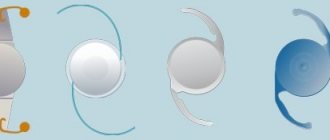Over the past 25 years of development of refractive surgery, ophthalmologists have achieved that today it is possible to correct almost any degree of myopia, farsightedness and astigmatism.
Phakic intraocular lenses are a salvation for patients with high degrees of myopia, farsightedness and astigmatism. They are the only method of surgical treatment for patients who are contraindicated for laser vision correction.
Benefits of phakic lens implantation:
- being in the eye, they do not come into contact with the iris and cornea, which prevents the possibility of dystrophy;
- unique biocompatibility with the human eye;
- protection of the retina from ultraviolet rays;
- vision is restored 2-3 hours after the operation;
- maintaining the integrity of the corneal structure
Implantation of phakic lenses is successfully used in cases where the natural accommodation of the lens has not yet been lost, and lenses can be implanted into the eye without removing the natural lens of the person. At its core, implantation of phakic lenses is similar to correction using contact lenses. Only contact lenses are placed on the cornea, and phakic lenses are implanted inside the eye in the posterior or anterior chamber of the eye, preserving the natural lens. Phakic lenses allow the eye to maintain the ability to see objects both near and far.
Implantation of phakic IOLs is a more advanced method of refractive surgery for high degrees of refractive error (myopia, farsightedness, astigmatism), as it is a reversible, stable method and does not violate the shape and integrity of the cornea.
Implantation of phakic IOLs is more physiological compared to the clear lens extraction method and is therefore suitable for younger patients.
With promising results and modern surgical and diagnostic equipment, PRL/MPL implantation is becoming one of the most interesting and promising areas of refractive surgery. 10 years of experience with PRL/MPL implantation provides encouraging results. The lenses are used in Europe, South America, China, and phase 3 FDA trials have been completed in the USA.
Pros and cons of methods
In the anterior chamber
, the lens is implanted quite simply, there is a fairly large space, the lenses in the anterior chamber are stable in their position over time (with mounting in the UPC), the optical design of the lens is simple and does not require complex technology, the material of the anterior chamber lenses can be rigid ( PPMA - then the incision for its implantation is 5-5.5 mm) and elastic (incision 2.5-3 mm).
But there are also plenty of potential problems with them:
- A progressive decrease in the number of corneal endothelial cells, which may at some point lead to the need for a new operation (after decades).
- Iris atrophy (especially with iris-mounted lenses) is unlikely, but attachments can damage the iris.
- Change in the shape of the pupil - ovalization, the eye turns into a “cat-like” one with an elongated shape,
- Chronic inflammation (because the iris is a plexus of blood vessels and nerves),
- Secondary glaucoma,
- Colored halos and glare.
If the lens “clings” to the iris:
- There is a potential risk of damage to the lens;
- There is a potential risk of hemorrhage from the iris and tearing of its pupillary edge;
- The lens may shift as a result of iris atrophy and sag;
- Another feature is that the lens in the anterior chamber is often noticeable to others. When light rays hit the eye, the lens glares and the interlocutor may notice that something is wrong.
With posterior chamber lenses, the opposite is true:
implantation is more difficult from a technical point of view, there is little space in the posterior chamber, potential rotation of the lens position over time is possible (no big deal, but this is important for astigmatic phakic lenses), the optical calculation of the lens is more complex and requires measurements using special devices, the material of the posterior chamber lenses must be elastic and repeat the geometry of the lens.
However, posterior chamber lenses are not visible cosmetically and can only be detected under a microscope. If the patient does not say, the doctor may not notice. In a regular clinic, for example, they almost certainly won’t see it.
A lens in the posterior chamber can also cause cataracts due to disruption of intraocular fluid circulation or direct contact. The current 10-year cataract risk for posterior chamber ICLs is 3-5%, but this study is older than the last generation of ICLs. New soft lenses have special perforations - in theory this means a reduction in risk to 1-2%, but there is no practice for a 10-year perspective yet - the technology is 4 years old.
The summary figure for reversible and irreversible complications in such operations is up to 6% over a 15-year period. The highest percentage of complications is typical for operations with incorrect lens selection - this lies on the conscience of manufacturers with models with little clinical practice, incorrect diagnosis, and then on the surgeon’s mistakes.
Advantages of PIOL implantation over laser vision correction
- The structure of the cornea is not disturbed when implanting phakic lenses;
- The operation is reversible - it is possible to remove (explant) the lens if necessary;
- Accommodation is preserved;
- Visual acuity is better than with glasses or contact lenses
| Recommended for the correction of visual impairment in patients under 40 years of age. |
ISLSTAAR phakic lenses are produced in Switzerland and certified by the Ministry of Health of the Russian Federation.
Implantation of phakic lenses in the clinic is carried out by ophthalmic surgeon, Professor Vyacheslav Mikhailovich Sheludchenko.
The surgeon is a proctor of the STAARSURGYCAL company in the Russian Federation, an expert in the technology of implanting phakic lenses ISL and can train ophthalmologists in surgical techniques.
To date, over 300 PIOL implantation operations have been performed.
Operation stages:
- Patient preparation. Local anesthesia. Installation of an eyelid speculum;
- Corneal puncture for lens installation;
- Implantation of a phakic lens behind the iris in front of the native lens.
No stitches are required. Outpatient management.
Good vision the next day.
The period of complete recovery and healing under the supervision of an ophthalmologist takes one month.
What is ultrasound biomicroscopy?
Ultrasound biomicroscopy - UBM is a method of acoustic visualization of intraocular structures of the anterior segment of the eye (cornea, iris, anterior chamber angle and lens) - a multifunctional combine for all types of ultrasound examinations (B-scanning, A-biometry, pachymetry).
The device allows you to obtain images of excellent quality, detailed, clear, with the highest accuracy. The circular matrix multifrequency sensor allows you to get the clearest image of the entire eye. The scanning system shoots at a frequency of 22 frames per second. Based on the resulting image, the software automatically calculates the corresponding details of the “relief”. The UBM sensor visualizes the anterior part of the eye chamber without violating the integrity of the eyeball, allows for a qualitative and quantitative assessment of its structures, and clarifies the spatial relationships of the cornea, ciliary body, iris, and lens in opaque refractive media, assess the condition of surgically created outflow tracts.
Not every clinic has such a device. Therefore, I say right away - if in your city phakic lenses are ordered without UBM results, then the surgeon orders them based on other diagnostic methods. Not exactly “on a whim,” but the risks grow quite significantly. For obvious reasons, it is better to know exactly the size of the spaces where implantation occurs, especially as technology allows. Another thing is that the UBM device is quite expensive, and not every center can afford such equipment for 10 operations per year. Well, this is also a contact research method, you need to be able to do it: it requires separate skills and training.
The result looks something like this:
Eye with phakic IOL
Then such an order is sent to the lens manufacturer, here is a standard form:
EYEPCL Data Sheet
| FULL NAME. Doctors/Contact Information/Dr Name & Contect Details | ||||||||||||||||||
| FULL NAME. Patient Name: | ||||||||||||||||||
| Data of Patient's Birth | ||||||||||||||||||
| Date | ||||||||||||||||||
| Right Eye | Left Eye | |||||||||||||||||
| Spherical | Toric/Toric | Presbyopic/ Presbyopic | Toric Diffractive/ Toric. diff | Spherical | Toric/Toric | Presbyopic/ Presbyopic | Toric Diffractive/ Toric. Diffraction | |||||||||||
| Refraction | Spherical | Cylinder | Refraction | Spherical | Cylinder | |||||||||||||
| Axis | *Addition for near vision | B.C.V.A. | Axis | *Addition for near vision | B.C.V.A. | |||||||||||||
| W to W (mm) | Method: Digital Caliper/Optical Biometry/IOL Master/Orbscan/ S to S (by UBM) | W to W (mm) | Method: Digital Caliper/Optical Biometry/IOL Master/Orbscan/ S to S (by UBM) | |||||||||||||||
| Pachymetry (µm) | Pachymetry (µm) | |||||||||||||||||
| ACD from endo (mm) | ACD from endo (mm) | |||||||||||||||||
| K1 (Flat) | Power | Axis | K1 (Flat) | Power | Axis | |||||||||||||
| K2 (Steep) | Power | Axis | K2 (Steep) | Power | Axis | |||||||||||||
| Axial Length (mm) | Optical/Ultra sonic | Axial Length (mm) | Optical/Ultra sonic | |||||||||||||||
| Lens Thickness (mm) | Lens Thickness, (mm) | |||||||||||||||||
| Back chamber/PCD depth (mm) | Back chamber/PCD depth (mm) | |||||||||||||||||
| Hir. Indian astigmatism/SIA | Cut Localization/Inc. loc | Hir. Indian astigmatism/SIA | Cut Localization/Inc. loc | |||||||||||||||
| Filled by CARE GROUP/Filled by CARE GROUP | ||||||||||||||||||
| Model IPCL/IPCL MODEL Size | Model IPCL/IPCL MODEL Size | |||||||||||||||||
| Calculated Diopter/ Calculated Power | Difference/Residual | Calculated Diopter/ Calculated Power | Difference/Residual | |||||||||||||||
| 1 | 1 | |||||||||||||||||
| 2 | 2 | |||||||||||||||||
| 3 | 3 | |||||||||||||||||
Arguments for and against surgery
The main disadvantage of implanting intraocular lenses is the financial side of the issue. High-quality diagnostics, ordering optics, implantation itself - all this costs a lot of money. Therefore, very often people choose other methods of vision correction.
Another difficulty is choosing a clinic and a qualified ophthalmic surgeon. Many people are frightened by the very fact of surgical intervention and the possible risks.
However, phakic lenses also have their advantages:
- modern implantation methods reduce the risks of postoperative complications to a minimum;
- the operation is reversible: if problems arise, the lens can always be removed;
- if laser correction is contraindicated, phakic lenses become an ideal alternative;
- the procedure does not violate the natural anatomy of the eye;
- The operation is well tolerated at any age and does not affect the heart and blood vessels.
There is a common myth that after implantation you will have to give up sports and physical activity. We inherited this belief from past, imperfect medical technologies. But today, operations to implant intraocular lenses are carried out at such a level that optics become an organic part of the eye, and a person can live a full life without fear of complications.
What's next?
We most often install a Worst Iris-claw lens (with “claws” for mounting on the iris) in the anterior camera.
In the back - a line of very soft elastic lenses ICL or EYEPCL, they are very thin and correct difficult cases well. Both types of lenses are ordered in Europe. Our partners take about a month to two to manufacture (to be a little more precise, they manufacture and grow) an intraocular lens. The implantation operation is similar to the ReLEx SMILE correction, only instead of cutting out the lens in the stroma and evacuating the tissue (lenticule extraction), we gain access to the existing free space inside the eye and deploy the lens there. In general, from the outside and in a very simplified way - SMILE, scrolled backwards. In short, the choice is simple:
Posterior chambers are safer, but after -14 the risk of cataracts increases significantly, so somewhere around -15-16 anterior chambers become safer. This is a global trend, and now almost all clinics make their choice according to this scheme (taking into account the individual characteristics of the patient).
Depending on the clinic, they may offer different types of lenses. Most often - according to the preferences of the surgeon and the clinic as a whole - someone relies on long-term stability, for others it is important to place them as painlessly as possible, and so on, for others they simply have extensive experience with one type of lens.
If side effects with the endothelium begin (and this is possible in the case of incorrect diagnosis in an operation with an anterior chamber lens, and not immediately, but in a 15-year perspective), then the only option to preserve vision in the long term is an endothelial transplant. In Russia they almost never do it (by the way, in our clinic we do just such transplants), in Europe the cost starts from 10 thousand euros. This operation is most often not included in insurance against side effects and complications. There was a recent case where a manufacturer recalled an entire batch of lenses due to an increased risk of complications with endothelialization. Yes, and diagnostics are quite expensive. A microscope is used to count endothelial cells: as a rule, only experienced doctors working with complex patients can afford it.
Surgical errors can be quite interesting. One of the most unpleasant (by the way, not uncommon cases) that I have encountered is the need to “turn over a phakic lens” that another surgeon had implanted “back and forth” before me. It is quite difficult to determine the orientation of ultra-thin lenses inside the eye during surgery - this must be done before, correctly placing the lens in the injector. The situation was accompanied by increased intraocular pressure, pain, low vision and required emergency intervention. In this case, the outcome was excellent - as soon as the operation to reposition the lens was completed, the eye calmed down, and the next day the patient saw 100%. It still shows up periodically and sees just as well.
Benefits of phakic IOLs
This method of treating refractive errors has several advantages:
- ensuring high quality vision with immediate results that cannot be achieved with laser correction;
- absence of photophobia, pain, lacrimation and other side effects after surgery;
- the implanted lens can be replaced with a new one without harm to eye health;
- phakic IOLs do not have an expiration date; they have to be changed only when vision indicators change;
- the procedure is carried out without removing the natural lens;
- The IOL is equipped with a filter that protects the eye from ultraviolet radiation.
The procedure is prescribed for ages from 21 to 45 years. After installation, a person does not need to use other means of correction. One lens can last a lifetime. Only with age-related changes in vision, additional reading optics are required.
What else is important to know about the progress of the operation?
The general scenario of the operation is in the previous post.
Here's what we haven't touched on yet: 1. A very thorough diagnosis is done before surgery.
. Be sure to examine the fundus of the eye with a wide pupil: if there are any breaks in the retina or areas dangerous in terms of detachment, they are coagulated with a laser. If this was done, wait two weeks for a tight adhesion to form. Then, a few days later (or on the day of surgery, depending on the surgeon’s preferences), a prophylactic laser iridectomy is performed - this is a micro-hole in the iris, like a valve for relieving excess pressure. Diameter is about 0.5 millimeters. And although modern lenses have holes for fluid circulation (lens manufacturers claim that they prevent an increase in pressure), such a “laser shot” also serves as reinsurance against a jump in intraocular pressure in the future. Many surgeons, not relying on the recommendations of lens manufacturers, traditionally took insurance when performing iridectomy and, as it turned out in a 10-year perspective, for good reason - their patients did not have problems with IOP.
2. On the day of surgery, the pupil dilates as much as possible.
Under local anesthesia, a puncture is made in the limbal part of the cornea (at the border between the transparent and opaque parts). This is done exactly there so that the entry site cannot be determined visually after a month, and opacities and adhesions do not form there. The anterior chamber is filled with a special viscoelastic preparation. Using an injector, a lens rolled into a tube is implanted. This lens is injected into the anterior chamber of the eye, straightened out, then its legs are tucked behind the iris with a special spatula - the lens is gradually transferred to the posterior chamber. This is why the pupil dilates - the large thing must be placed almost expanded under the iris. Then the pupil is narrowed with a special preparation, and the lens fixes itself. The viscoelastic is then removed from the eye cavity. We blindfold the patient for a couple of hours to prevent infection. Then drops for a month, two weeks without a bath. As a rule, you can see “to the fullest” by the evening. Restrictions - as with any abdominal surgery, a two-week ban on sports.
3. What can the patient see during surgery?
A light before my eyes. The lens itself is not visible; it does not come into focus at all. You won’t be able to blink as usual; your eyelids will be held in place by a spring. The eye only feels touch, there is no painful sensation. The “nervous” part of the operation, when you have instruments in your eye, is about 5 minutes. Both eyes are not done at once - one at a time, usually every other day. This is the rule of abdominal operations.
4. Price.
Usually, patients quite easily decide to use phakic lenses when they understand that although this is an abdominal operation, it is the only possible one for them and is comparable in risks to laser correction. The main limiter is the cost of the operation: implantation of a phakic lens in one eye costs 180,000 rubles, which is more expensive than any type of laser correction.
That's it, now the topic of phakic intraocular lenses is closed - you know almost everything you need about this method of correction (well, you can ask questions). Next I will talk about safety glasses, contact lenses and their features, and then we will touch on vision issues specifically for IT specialists.
Video about phakic PRL/MPL lenses
The necessary conditions for the use of phakic lenses are high requirements for the accuracy of calculation and selection of a specific type of lens, and the quality of work of the ophthalmic surgeon.
When selecting the type of phakic lenses, ophthalmologists at the International Ophthalmological Center take into account various features: the individual state of eye optics, the patient’s age, his lifestyle, and type of activity. Our specialists have appropriate certificates from manufacturers of phakic intraocular lenses, which gives them the right to implant phakic lenses and guarantees the highest quality of eye surgery.











